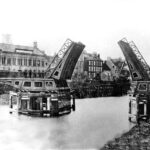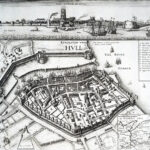23 December 1732: The Hornsea hurricane of today, and the miraculous escape of the Gales, as recalled for the Rev. William Whytehead by his parishioners 55 years later
George Poulson. 1840. The History and Antiquities of the Seigniory of Holderness, in the East-Riding of the County of York, Vol. 1. Hull: Robert Brown. Get it:
.Excerpt
It arose from the Mere in a direction towards the sea, destroying and unroofing 24 houses, 14 barns and other outhouses standing near the market cross, or within 150 yards on each side of it, besides the damage which the church sustained. It blew down the east end of the vicarage house, and took off its roof, and though Mr Gale, the curate, and his numerous small family were then in their beds, not one received the least injury. Immediately after the storm, he went running over to their house with a young child in his shirt lap, saying, “This is all I have left,” supposing the others to have been killed. The hurricane, in its progress towards the sea, overturned the windmill in the field called the Dales, and the mill stones were carried 150 yards. Sheets of lead were blown from the church, and wrapped round two sycamore trees, now standing in Hall Garth. A woman and child, who were in bed together, in a chamber of one of the unroofed houses, were blown into the street with the bed under them, and received little, if any, bodily harm. I was then here aged four with my grandfather Ogle in East Gate, but he did not perceive any violent wind, nor was there any damage done in all that street.
Comment
Comment
Something to say? Get in touch
Original
On December 23, 1732, a violent hurricane arose here at night, which, from its short duration and singular effects is deserving of notice. The Rev. Wm. Whytehead, when many of his parishioners were in existence, who were eye witnesses of its devastations, thus describes it; his account is dated in 1787. “There are some remarkable circumstances related of this hurricane by many old people in this place. It arose from the Mere in a direction towards the sea, destroying and unroofing 24 houses, 14 barns and other outhouses standing near the market cross, or within 150 yards on each side of it, besides the damage which the church sustained; it blew down the east end of the vicarage house, and took off its roof, and though Mr. Gale, the curate, and his numerous small family were then in their beds, not one received the least injury; one of my neighbours tells me that, immediately after the storm, he, the curate, went running over to their house with a young child in his shirt lap, saying, this is all I have left, supposing the others to have been killed. The hurricane, in its progress towards the sea, overturned the windmill, in the field called the Dales, not far from the footpath leading from the church to the beck, and what was very extraordinary, the mill stones were carried 150 yards from the mill by the strength of the wind. Sheets of lead were blown from the church, and wrapped round two sycamore trees, now standing in hall garth. A woman and child, who were in bed together, in a chamber of one of the unroofed houses, were blown into the street with the bed under them, and received little, if any, bodily harm; a beam was blown from a house on the west side of the street, into the garret window of a house on the other side of the street. Mrs. Moore, (the then child) is now living here; the old woman, her aunt, she says, did not live many weeks, but whether her death was accelerated by the fright she could not say. I was then here with my grandfather Ogle, (in my fourth year) who lived in East Gate, he did not perceive there was any violent wind, nor was there any damage done in all that street.” A memorial, dated in 1732, seems to have been presented to the magistrates, assembled in quarter sessions at Beverley, setting forth that the damage done by the hurricane, to those alone who wanted assistance, amounted to £264 10s. 8d. and their distress was such as to require immediate relief.
432 words.
Similar
 1 July 1840: The opening of the Hull and Selby Railway terminates the threat to Hull’s port from Goole, Scarborough and Bridlington
1 July 1840: The opening of the Hull and Selby Railway terminates the threat to Hull’s port from Goole, Scarborough and BridlingtonSearch
Donate
Music & books
Place-People-Play: Childcare (and the Kazookestra) on the Headingley/Weetwood borders next to Meanwood Park.
Music from and about Yorkshire by Leeds's Singing Organ-Grinder.




 Bluesky
Bluesky Extwitter
Extwitter